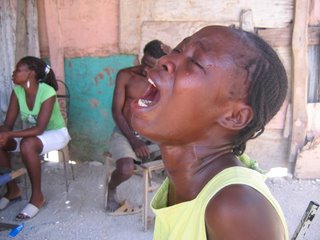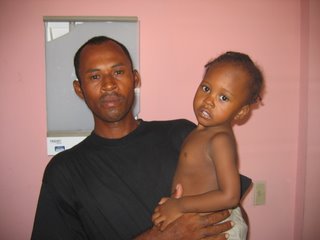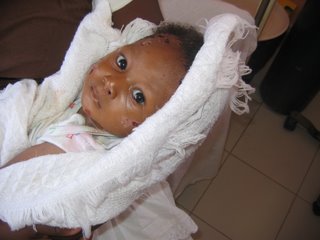
Attention: Secretary-General Kofi Annan, United Nations
Dear Secretary Annan,
Pediatric Clinic in Port au Prince this morning began as usual. The first baby was seven months old, had a fever, and was breathing 84 times per minute. Both lung fields had wheezing and crackling sounds. The baby was fussy but not especially toxic appearing. I took him to the rehydration room and started bronchodilator aerosol therapy which he seemed to like. The baby was also given a shot of a strong antibiotic and sent home to return tomorrow.
The second baby was a four day old that I saw yesterday with a fever of 103. The baby had been born at home with a midwife (matron) helping with the delivery. The only source of fever that I found was an umbilical cord that was tied off with a dirty piece of string. The matron had cut the cord with a Gillette. I gave this baby a big dose of antibiotics and advised the mother that fever in a baby this age could be very dangerous and even deadly. As she promised, she returned to the clinic today. The baby was afebrile today and looked ok. We changed the umbilical dressing again and gave the baby another shot of antibiotics.
Secretary Annan, as I was beginning to call the third patient into the room, my office door burst open. Falling into the room was the sobbing mother of Ferna who we admitted to the hospital in April. Her face was contorted in pain, sweaty, and tears were flowing as she was screaming, “Ferna died!” I tried to deny this was happening, but after so many years in Haiti, I knew almost immediately this was indeed happening and this is how death takes Haitian children and destroys their mothers. Ferna’s mother is named Yanick.
I literally drug Yanick into my office as she knelt on one knee and sobbed uncontrollably. I closed the door as all the mothers and babies in the waiting area were witnessing the grief of this young mother. I stood over her and rubbed her back not knowing what else to do. Her shoulders were shaking in grief. She told me that she had just come to the hospital across the street to visit Ferna and was told by the nursing staff that Ferna had a seizure and died last night. Ferna’s bed was empty. She had lost her ten month old precious child.
After several minutes of talking, I was able to lift her into the chair where children and their mother’s sit and tried to calm her down some more. Nurses came in the room and put dossiers on my desk barely recognizing the sobbing 29 year old mother in front of them. It wasn’t a sign of rudeness on their part. It was just another routine day in a Haitian pediatric clinic.
Secretary Annan, my heart and insides were repulsed with everything. I didn’t want to see any of the patients or their dossiers that were quickly piling up on my desk. I just wanted to leave. But I knew that would be wrong for many reasons.
After a few more minutes I helped Yanick to the exam table in the office where she laid down and with coaxing was able to slow her breathing. Profuse sweat and tears still flowed freely as she wailed again and again, “Oh Jesus! Ferna is dead”. Her eyes searched my eyes as if she was asking if what she was saying was really true. The pain on her face was so deep.
I noticed that on the floor next to my desk was a piece of cloth that the mother with the febrile infant had accidentally dropped on the floor when she left my office. I poured cool water on this cloth and placed it on Yanick’s forehead and temples and covered her eyes.
I told her that Ferna was in Heaven and would watch over her now in Haiti and that God wanted her and she couldn’t question that. I told Yanick that Ferna would now help her when she fell under Haiti’s heavy load. She nodded her head. Tears rolled down the side of her face under the wet cloth, but she said nothing. This was all very horrible.
I made the decision then that I needed to get it together, as Yanick had done, and see patients that were waiting. I let Yanick lay there while I examined children all morning and gave their mothers advice. I wondered what Yanick was thinking about all of my “advice” at that point.
The mothers would stare at Yanick as she laid about 8 feet from them as I examined their children. Word had spread in the waiting area that she had lost her baby. No one offered any sort of support for her whatsoever. They all had their own problems with their sick little ones. Severe poverty everywhere is paralyzing.
During the day, I changed her wet compress frequently. Yanick continued to lay supine and remained silent. She may have gone to sleep. Towards the end of the clinic, I offered her Coke which she sat up and drank and then laid back down.
Yanick and her husband come from a city an hour north of Port-au-Prince and had rented a tiny room in a nearby slum named Jeremy City. She needed to get back to the slum to call her husband, who she thought had gone home, and tell him of Ferna’s death. Ferna’s little body will be held in the morgue at our hospital and then transferred to the general hospital morgue downtown where her mother and father will have to retrieve it if they want to bury her near their home. Another problem is they need to hire an ambulance to transport their daughter because no tap-tap driver will knowingly take a corpse. That, of course, is an expensive ordeal and is the reason some Haitians take their loved ones home from the hospital right before they die so they don’t incur the cost of transporting the body. The last few days, Yanick seemed quite concerned when she came to the clinic to visit, but Ferna’s death was not anticipated.
As Yanick and I prepared to leave the clinic, the head nurse told Yanick to protect me because of the frequent kidnappings in the capital as I walked her to her slum. Yanick promised she would as her body was still shaking in distress from her daughter’s death. At that point, I did not know who was helping whom.
Secretary Annan, Yanick and I left the clinic and headed out onto the street that runs in front of the hospital. The sun was out in full and helicopters were circling above us with your arrival and first visit to Haiti. How did Port-au-Prince look from the air?
As we walked up the crowded street Yanick started to weave and began crying again. I lightly held her right elbow. Many people watched us as we proceeded. A number of women tried to help her and talk to her as she kept repeating, “Ferna is dead”. After we walked one half mile one of her leather sandals fell apart and she walked barefoot on the hot cement until another lady retrieved her shoe, fixed it with a piece of wire, and Yanick slipped back into her pathetic sandals.
We soon turned down a paved road as Yanick pointed to the left and after walking another quarter mile arrived in her horrible slum. I asked Yanick if we were close to where she and her husband were staying and she said yes. Dust, squalor, dogs, and debris were everywhere. A few feet later, she began pounding on a door and screamed wildly. The door was opened slightly by a woman and we slipped inside.
There were about 5 adults and 3 kids in a small central area with the whole compound about 40 square feet. The heat inside was unbearable. Their seemed to be no air circulation. Two babies were perched on a green army cot and a smiling eight year old boy was squatting next to them on the dirt floor. The roof was corrugated steel, and three of the four walls were slapped together with steel and pieces of plywood. The fourth wall was made out of 10 foot high compressed garbage.
Yanick immediately began jumping up and down in the dirt, barefoot and screaming that her baby had died. The adults looked at her but only the lady that let us in did anything. She gave Yanick two tablespoons of real strong appearing cold coffee loaded with salt, as Yanick fell into a broken metal chair. Amazingly, a 20 year old looking man was sitting in another beat up chair a few feet away receiving a pedicure from a teenage girl who barely looked up from her job.
Someone told Yanick that her husband was in their room. This startled both of us and she walked about 15 feet around the side of the compound. I followed her and looked into a small dark room and saw her husband lying on a thin cloth mat on his stomach. He looked up just briefly at us as Yanick screamed about Ferna’s fate. He then put his head back down and said nothing.
After about 15 more painful minutes, I felt my contributions were extremely minimal at this point, and told Yanick I would see her back at the hospital in the morning. We would talk about what to do with Ferna.
I felt no fear from anyone walking out of the slum that has been the home for this mom and dad as they visited their hospitalized daughter almost everyday since April. What I witnessed today will forever be etched in my brain. The pain of the poor is horrifying. I have seen many babies die in Haiti, but Yanick’s total desperation, grief, and loneliness in a city of three million people were too much.
Ferna had congenital heart disease and tuberculosis. She put up a great fight but the cards were stacked against her from the beginning. We couldn’t find a hospital for her in the United States to repair her heart. Ferna gave us time, but we who have everything didn’t come through.
Secretary Annan, as I walked home, the helicopters continued their security checks as you were arriving to meet with Haiti’s leaders. The misery on the ground is intense. We all hope your meetings with Haiti’s new leaders will be productive.
Sincerely,
John A. Carroll, MD






